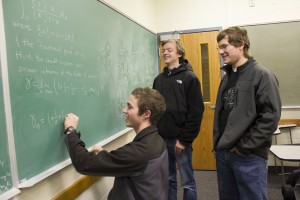About 45 BYU students and 4,200 undergrads nationwide participated in the William Lowell Putnam Mathematical Competition, a six-hour, 12-question exam in which the bottom half of participants are not awarded even a single point.
“Imagine a test where you fail to solve most of the problems, and you still beat everyone else,” Hiram Golze said, who competed on the BYU team.
Most students compete as individuals, but math professor and Putnam coach Tiancheng Ouyang got to select three to officially represent BYU.
“The scores of our team members were 41, 41, and 50 out of 120 points, and each of us placed among the top 100 students in the nation,” Golze said.
Their seventh place finish was BYU’s first time in the top ten, putting them in the company of schools like Princeton and Yale.

The test can seem like a fruitless endeavor at times, but it’s satisfying to finally arrive at a solution, according to Andrew Huff, a freshman from Pennsylvania.
“For the second part of the test, I spent almost all of the three hours working on the first problem with what I thought was little success,” Huff said. “With only three minutes left on the clock, while I was still lost, wandering around the mathematical landscape, I suddenly realized that I had found a solution. I had just barely enough time to write up a coherent proof.”
This is a different type of problem-solving experience than many have had in mathematics classes, according to Joseph Ward, a sophomore from Arizona, who also took the test.
“While you are first learning a mathematical technique, you just memorize how to use it and the rules behind it,” Ward said. “When you work on a contest math problem, though, everything is different. You don’t know which techniques to use and you can’t do it mechanically. That’s where creativity comes in. When you have no idea where to start, try something, be creative. If it works, great. If not, go back to the beginning and use your creativity again.”
Sam Dittmer and Peter Baratta are the two other students on the official BYU team with Golze. They are all featured in a recent video marketing BYU math, a follow-up to last year’s BYU Mathletes Rap.
That video opens with the question ‘What if we treated star students like star athletes?,’ and the university is trying to do just that, according to Joe Hadfield of University Communications.
When the team heard how well they did, they mostly contained their excitement.
“I was really happy, but I didn’t run through the halls screaming,” Baratta said. “Now I kind of regret not doing that.”
Dittmer agreed that it was nice to place so high, but he also pointed to a deeper satisfaction that comes from mathematics.
“People have this idea about math being something you either know or you don’t,” Dittmer said. “But doing math isn’t memorizing a map, it’s learning how to explore.”




